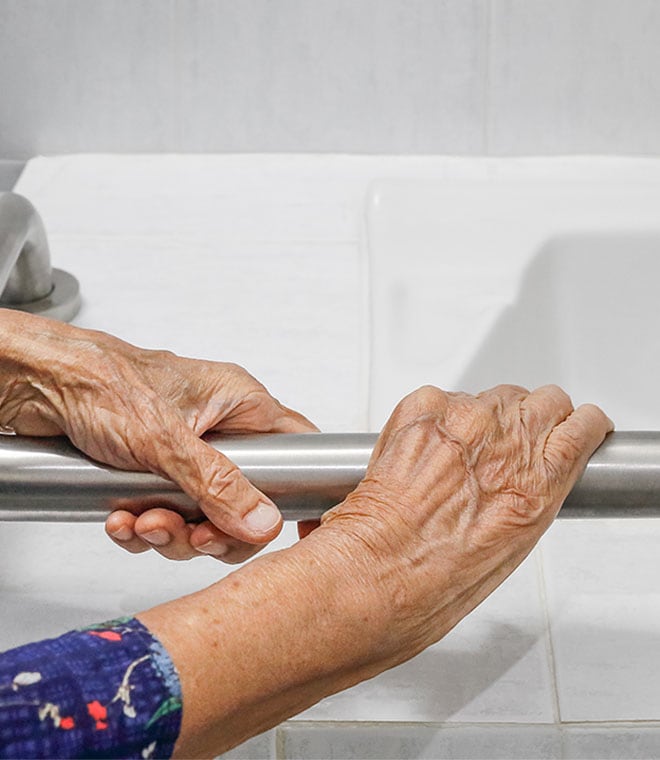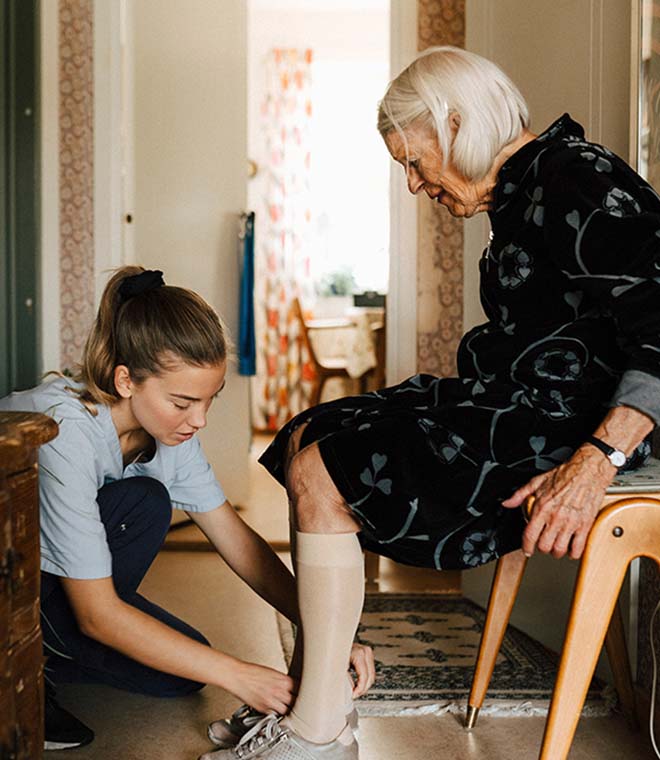Wellness
Incontinence: An overview for caregivers
By Kerac Falk, MD Jun 25, 2025 • 13 min
Incontinence is the term used to describe a loss of control of the bladder or bowel. Caring for someone with incontinence can be challenging, but there are things you can do to make symptoms easier to manage while also supporting your loved one’s hygiene, health and well-being.
What are the different types of urinary incontinence?
There are six main types of urinary incontinence:
- Stress incontinence: With stress incontinence, urine leakage typically occurs during a movement or activity that places pressure on the bladder, such as exercise, coughing, sneezing or laughing. It typically occurs due to weakness in the pelvic floor muscles, which support the bladder. Women often experience stress incontinence due to changes in the body related to childbirth, age and menopause. For men, one of the most common causes is damage caused by prostate removal.
- Urge incontinence: Also called “overactive bladder” or “urgency incontinence,” this type of incontinence occurs when someone has a sudden, urgent need to urinate followed by a loss of bladder control. In some cases, frequent urination occurs as well. Urinary tract infections can cause short-term urge incontinence. Chronic urge incontinence is usually due to problems with the nerves that control the bladder muscle.
- Overflow incontinence: With overflow incontinence, the bladder doesn’t empty fully with urination. As a result, urine backs up and eventually leaks out. Prostate problems are the most common cause of overflow incontinence in men. Women may develop overflow incontinence with prolapse, a condition where the uterus drops out of position. Aging, nerve damage and some medications can also cause overflow incontinence.
- Neurogenic bladder: Usually caused by nerve damage, neurogenic bladder (or reflex incontinence) occurs when urine suddenly leaks out of the bladder without any warning. Leaking is often heavy with this type of incontinence.
- Functional incontinence: When someone has normal bladder control but has difficulty making it to the bathroom in time, it’s called “functional incontinence.” This type of urinary incontinence affects those with limited mobility due to conditions such as arthritis, as well as people with conditions that make someone unaware or less aware of the need to urinate, such as Alzheimer’s disease.
- Mixed incontinence: In some cases, an individual may have more than one type of incontinence, such as urge incontinence and stress incontinence. The term for this is mixed incontinence.
What causes fecal incontinence?
Common causes of fecal incontinence include diarrhea, constipation, and muscle or nerve damage.
What are the different types of fecal incontinence?
There are two main types of fecal incontinence:
- Urge incontinence: People with urge incontinence experience a sudden, urgent need to defecate and an inability to hold it in until they reach the toilet. Some causes of this type of incontinence include diarrhea, hemorrhoids, and damage or weakness of the muscles in the anus, rectum or pelvic floor.
- Passive incontinence: With passive incontinence, a person experiences loss of bowel control due to an inability to sense the presence of stool in the rectum. This type of incontinence often happens due to damage or dysfunction of the nerves in the anus or rectum.
Exploring treatment options for your loved one
Incontinence is often treatable. Your loved one’s healthcare provider can diagnose the cause of their bowel or bladder control problems and develop a treatment plan to help manage their symptoms. Potential treatments to effectively manage incontinence include:
- Diet: Overactive bladder and urgency incontinence may improve by avoiding common bladder irritants such as caffeine, carbonation, sugar, artificial sweeteners and alcohol. Adequate water intake is encouraged. For fecal incontinence, dietary modifications include increasing fiber and water intake and avoiding foods that cause diarrhea, such as sugary, fried or fatty foods and dairy.
- Pelvic floor exercises: Physical exercises that improve muscle strength and tone may be recommended for people who experience incontinence related to pelvic floor muscle dysfunction. One example is the Kegel exercise, which involves tensing the pelvic floor muscles for a few seconds and then relaxing them.
- Pelvic physical therapy: It is often difficult to learn how to rehabilitate pelvic function without expert guidance. Physical therapy focused on the pelvis is an essential intervention for any type of urinary or bowel incontinence. This type of therapy helps re-educate the pelvic floor to function correctly and avoid accidents. You can ask your healthcare provider for a referral to a pelvic floor specialist in your region.
- Biofeedback: With this type of therapy, people with incontinence learn how to sense their need to urinate or have a bowel movement sooner. They may also learn how to better control the muscles that manage the bladder or bowel until they reach the toilet. This is best performed with the guidance of a physical therapist.
- Medications: For urge urinary incontinence, Anticholinergic medications or beta-3 agonists may be prescribed. Anticholinergics should be avoided in older people (age 65 and older) or those with cognitive impairment or dementia. Alpha blockers are sometimes used to treat overflow and urge urinary incontinence in men. Fiber bulking and anti-diarrheal medications may be an option for people who experience fecal incontinence.
- Botulinum toxin A (Botox): Injections of botulinum toxin A are effective at reducing the symptoms of urge urinary incontinence in some people.
- Catheters: If your loved one has overflow incontinence, they may benefit from the use of catheters, which are tubes that are inserted into the urethra to drain urine from the bladder.
- Devices: Medical devices may be used to prevent accidents. For women with urinary incontinence, healthcare providers may recommend vaginal inserts or pessaries. For men, penis clamps may be utilized. Vaginal inserts are also sometimes used to treat fecal incontinence in women. Anal plugs are a solution for some people with bowel incontinence.
- Bulking agents: Injections of gel near the exit of the bladder or anus can reduce leakage associated with some types of incontinence.
- Electrical nerve stimulation: Devices that stimulate the nerves can improve symptoms of some forms of urinary and fecal incontinence. This can be an office-based procedure (tibial nerve stimulation). Devices may also be implanted under the skin during a surgical procedure (sacral neuromodulation).
- Surgical procedures: In some cases, surgery may be necessary to treat incontinence. For urinary incontinence, healthcare providers may recommend procedures that provide more support for the bladder or strengthen the neck of the bladder, such as midurethral slings or artificial sphincters. Surgery to correct problems with the muscles may be beneficial for treating bowel incontinence in select patients.
Tips for managing your loved one’s incontinence
When caring for someone with incontinence, following these tips can help you better manage the symptoms and reduce the risk of some complications associated with a loss of bowel or bladder control:
- Start a daily log: To help your loved one’s healthcare provider manage their treatment plan, keep a daily log of their symptoms. Record how often they toileted successfully, how many accidents occurred and when they happened. Also, note what and when they eat and drink throughout the day.
- Adopt a toileting schedule: Encouraging your loved one to use the bathroom on a set schedule can lower the likelihood of accidents. Ask their healthcare provider for assistance with creating a schedule.
- Discuss their fluid intake needs: If your loved one has urinary incontinence, find out how much fluid they should be getting daily from beverages and foods from their healthcare provider. Try not to exceed the recommended amount and avoid offering too much fluid late in the day to cut down on bed-wetting.
- Watch their diet: Dietary changes are often beneficial for both urinary and bowel incontinence management. Certain things, such as spicy foods and caffeinated drinks, can irritate the bowel or bladder and increase the risk of accidents. Adding more fiber to your loved one’s diet may also be beneficial for managing fecal incontinence. Talk to your loved one’s healthcare provider about what they’re eating and ask for advice on where to make changes.
- Keep them dry with wearable protection: Wearable incontinence protection products can help keep your loved one clean and dry throughout the day. For urinary incontinence, you can choose between adhesive incontinence pads worn inside regular underpants and incontinence underwear, which replaces regular undergarments. When your loved one has an accident, change their incontinence protection as soon as possible to control odors and keep the skin dry.
- Compare absorbency options carefully: Wearable incontinence protection products come in different levels of absorbency, and each brand has its own labeling system. Read the packaging or online product information carefully, so that you can choose the right option for your loved one’s needs. You may also want to use more absorbent products overnight or when you’ll be out of the house for long periods of time.
- Simplify toileting: If your loved one has functional incontinence or experiences urinary or bowel urgency, consider using a bedpan, urinal or commode, so that they can skip the trip to the bathroom. Installing grab bars around the toilet in the bathroom can also make transferring easier and safer.
- Protect bedding and upholstery: To cut down on cleanup after accidents, use disposable or washable pads on upholstered furniture and under bedding. Keep a spare set of sheets ready to facilitate quick bedding changes as needed.
- Maintain their hygiene: When your loved one has an accident, clean their private area thoroughly to combat germs and curb odors. Mild soap and warm water are often the best choice for cleansing, but you can also find spray-on cleansers and wipes designed specifically for incontinence care.
- Address irritation early: Skin irritation is common in people who suffer from incontinence and can worsen quickly. Inspect your loved one’s skin regularly for redness and swelling that indicate inflammation. Apply a barrier cream to help prevent skin irritation. When you do notice signs of skin problems, consult your loved one’s healthcare provider for treatment recommendations.
Updated June 2025.
Sources:
- https://www.nia.nih.gov/health/bladder-health-and-incontinence/urinary-incontinence-older-adults
- https://www.mayoclinic.org/diseases-conditions/urinary-incontinence/symptoms-causes/syc-20352808
- https://www.health.harvard.edu/bladder-and-bowel/types-of-urinary-incontinence
- https://www.mayoclinic.org/diseases-conditions/fecal-incontinence/symptoms-causes/syc-20351397
- https://www.mayoclinic.org/diseases-conditions/stress-incontinence/symptoms-causes/syc-20355727
- https://www.health.harvard.edu/diseases-and-conditions/is-something-in-your-diet-causing-diarrhea#:~:text=Watch%20out%20for%20cheese%2C%20milk,get%20burning%20in%20the%20rectum.
- https://www.mayoclinic.org/diseases-conditions/urinary-incontinence/in-depth/bladder-control-problem/art-20046597
- https://medlineplus.gov/ency/patientinstructions/000146.htm
- https://www.health.harvard.edu/staying-healthy/effective-practical-strategies-for-coping-with-urinary-incontinence



